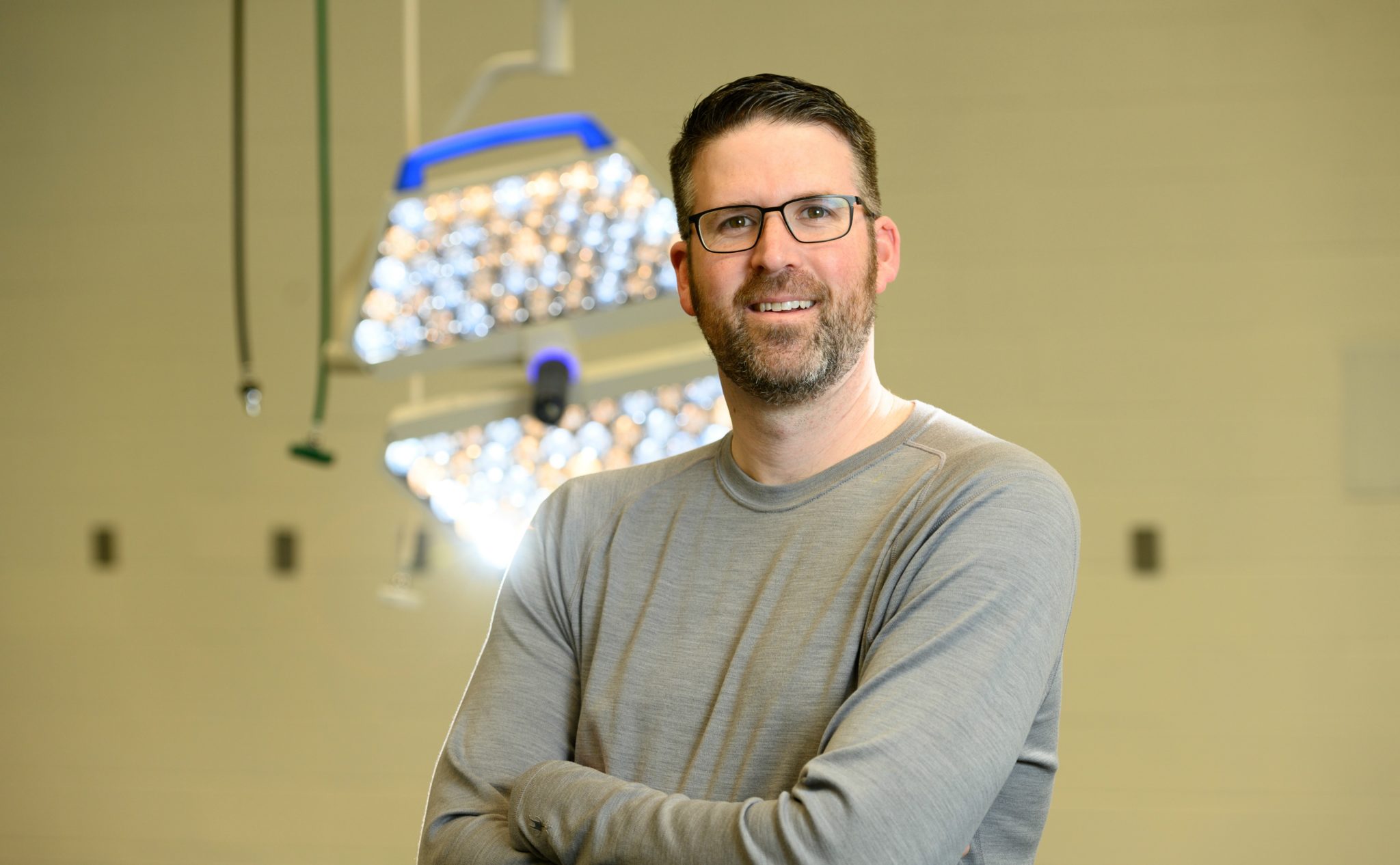
Dr. Jeremiah Easley is described by his peers and team as humble, gifted at nurturing relationships, driven and a great mentor. Photo: John Eisele/ CSU Photography
Dr. Jeremiah Easley’s career path has come full circle. As a young boy, he lived with his family in Fort Collins while his father, Jack — an accomplished equine veterinarian — completed a sabbatical under Dr. Simon Turner at Colorado State University.
Now, Jeremiah Easley serves as co-director of the Preclinical Surgical Research Laboratory at CSU, which was launched by Turner more than 20 years ago to test new medical devices for use, eventually, in human patients.
To date, the laboratory has worked with companies — including startups — on more than 30 devices that have been approved by the U.S. Food and Drug Administration following testing at CSU.
Growing up as a veterinarian’s son, Easley said, he always had an interest in the field, but he wasn’t sure if it was for him.
He explored other areas as an undergraduate, majoring first in art and then marine biology. But he was ultimately drawn to veterinary medicine, and received his DVM from Virginia-Maryland College of Veterinary Medicine in 2007. While there, he began to formulate his career goals, which included specializing in surgery.
Easley landed an internship with an equine veterinary practice in Ocala, Florida, which further fueled his interests in equine surgery, then completed a residency at the University of Florida in large animal surgery.
Research Excellence
Dr. Jeremiah Easley is the recipient of the 2018 Zoetis Veterinary Research Excellence Award, which recognizes researchers whose innovative studies have advanced the scientific standing of veterinary medicine. He’ll kick off the 20th annual CVMBS Research Day with a keynote address about the importance of collaboration in the workplace at noon on Saturday, Jan. 26, at the C. Wayne McIlwraith Translational Medicine Institute. Global animal health company Zoetis sponsors both Research Day and the Research Excellence Award.
Determined, but in a ‘good way’
Easley returned to Fort Collins in 2011, after his wife, Dr. Jennifer Hatzel, lined up a residency with Dr. Patrick McCue in the Equine Reproduction Laboratory at CSU.
He interviewed for a temporary position at the Preclinical Surgical Research Laboratory, where Dr. Howard Seim III, the lab’s director, said he thought Easley might stick around for a few years. Instead, he learned quickly yet stayed humble.
“He’s unbelievably good at nurturing relationships with corporate sponsors and companies,” he said. “He’s gone from being the new kid in town to the guy who I named my co-director after four years.”
Seim described Easley as “very driven,” but in the best of ways.
“He is driven to make a community of people in a team that can function together to absolutely be successful, and everybody can share in the success,” he said.
Tackling neurological disorders, spine issues, osteoporosis
Easley described the work of the Preclinical Surgical Research Laboratory.
“We provide the ability to help take products from just a simple idea all the way to being implanted in patients, whether they be animals or people,” he said. “Some of the most exciting work I do is when I see a product and recognize that the idea came about because a human patient had a problem, and we come up with a way to fix it. There’s a way to translate that back to the horse or the dog, too.”

Many of the devices that are evaluated in the lab fall under the realm of neurosurgery. Researchers hope their tests will lead to improvements for the treatment of osteoporosis, spinal disease, disc regeneration, epilepsy, traumatic brain injury, Parkinson’s disease and pain in humans and animals.
Dr. Yvette Nout-Lomas, an associate professor in the Department of Clinical Sciences who works in equine internal medicine at CSU, is currently collaborating with Easley on treatments for horses with Wobbler syndrome, a neurological disease that leads to compression of the spinal cord, and loss of control of the animals’ legs. It is the most common neurological condition that affects horses in the United States, but CSU is one of only a handful of centers around the world that treats Wobbler syndrome.
The team has treated more than a dozen animal patients to date, with promising results.
“Overall, the success rates have been between 65 to 70 percent,” said Nout-Lomas. “It’s exciting to have somebody like Jeremiah, who is interested in expanding and innovating the current status for horses with Wobbler syndrome, at CSU.”
Achieving goals
Erin McCready is pursuing a master’s degree in the Department of Clinical Sciences, and a member of the lab. She described Easley as a great boss and a wonderful mentor, someone who works incredibly hard, but who also likes to have fun.
“Of anyone I’ve ever worked for, he’s the most invested in figuring out what people want to do with their lives, what their goals are and how he can help us achieve them,” she said. “It’s really important for him to build a team that will get work done and also work well together. It’s a priority for him.”
Easley said it’s imperative for students to see themselves as integral parts of the lab. He and Seim include the students, staff and veterinary technicians in dinners with corporate clients, send them to national conferences, and hold team-building experiences, including renting out an arcade for a few hours of down time.
“I hope that when students leave our lab, they recognize what it’s like to be part of a good working experience, where teams work together and get a lot of work accomplished,” said Easley.
“I give tons of credit to Simon Turner and Howie Seim,” he said. “Simon developed the lab 25 years ago and he, with Howie’s help, built a wonderful working culture in the lab that was very much like what I envisioned. It’s allowed me to take that and make it my own.”